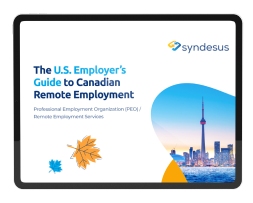As companies navigate the changing landscape of work, geographical borders are becoming increasingly irrelevant in certain sectors. Notably, the technology sector has seen a significant uptick in remote working opportunities.
Immigration, Refugees and Citizenship Canada recently unveiled a new work permit targeting immigrants in the US holding H1-B work visas. Strategically designed to attract these individuals to Canada by offering three-year open work permits, the initiative has proven to be highly successful — the program swiftly reached its 10,000-applicant cap within just two days of its launch.
This is unsurprising considering H-1B workers in the US have been facing an increasingly challenging immigration process. Recent tech layoffs have also put many H-1B workers in a position where they have to quickly find work in order to remain in the US, in a much more competitive environment than before. Employees have, naturally, been weighing up their options and looking overseas to countries with favorable immigration pathways, such as Canada. However, it’s expected that a significant percentage of immigrants will eventually leave Canada due to low wages.
So, what if you are a H-1B worker who has moved to Canada and enjoys the lifestyle and perks of living there, but still ultimately want a US salary? There are options. We’re going to discuss one strategy open to you that offers the best of both worlds — literally.
What are the benefits of staying in Canada for H-1B holders with Canadian work visas?
There are a number of reasons why an individual would move to and want to stay in Canada. A favorable immigration process means that tech workers have a quick and clear pathway to permanent residency and citizenship via the Global Talent Stream program, which isn’t the case in the US.
Canada’s Global Skills Strategy — empowers Canadian employers to speed up the process of hiring foreign workers to fill specialized jobs. An employee can obtain authorization to work in Canada within less than two weeks, and within a few weeks from there, obtain a Canadian work visa, relocate, and begin working in Canada.
Canada has a global reputation for being a welcoming country to immigrants, who already make up one-fifth of Canada’s population making it an ideal environment to start a new life.
Tech workers are also increasingly in demand, Toronto is now the third-largest technology hub in North America, and it is estimated that Canadian employers will need to fill an additional 250,000 technology jobs by 2025.
Being a permanent resident of Canada also grants access to public services such as the Canadian national healthcare system and a world-class education at the secondary and university level.
Though there are numerous benefits to remaining in Canada, the allure of a higher salary, typically available to tech workers in the US, can make the decision to stay in Canada long-term a little more tricky. So how do you get the best of both worlds?
How can you keep earning a US salary while still living in Canada?
Essentially, by finding opportunities to earn US wages by remote working for an American company. Physical location is much less of a concern for employers than in the past. Canada’s proximity to the US, and its favorable time zones, make it an ideal remote work location. Teams can still collaborate and employees can participate in key in-person events by flying in when necessary.
Tech professionals truly can enjoy the best of both worlds, a vibrant career with US wages and the stability and quality of life that Canada consistently delivers. If your current or desired US employer doesn’t have an office based in Canada or isn’t familiar with the specifics of hiring remote workers in Canada, they have options.
Employers can partner with a Professional Employer Organization (PEO) which can take care of the technical aspects of employment for them. They don’t need expertise in Canadian immigration or employment law nor do they need to hire attorneys, accountants, and other professionals. The PEO handles HR, compliance, tax, and immigration.
If your US employer has never hired anyone remotely in another country, this isn’t a typical conversation to have with them. This means you need to make a case for it, we’ve made a list of five reasons that you can present to your employer to make the case why having a presence in Canada is beneficial to them.
The US company gets to hire and retain key talent, avoid the difficult H-1B visa process altogether, and have easy access to that employee when needed. It’s a win-win situation.
Syndesus can help you get started in Canada and let you continue to work for an American employer
Whether you are about to relocate to Canada and want to retain your current tech job or you are looking to work for an American employer from Canada, Syndesus can help. And if your US employer doesn’t have a Canadian office, no problem.
As a professional employer organization (PEO), Syndesus can legally hire you on behalf of your US employer. We take care of the billing, HR, legal and other paperwork, and you carry on working in Canada.
Reach out to us to learn more about how we can help you work remotely for a US tech company from Canada, or join our Path to Canada database of qualified candidates seeking to move to Canada.




